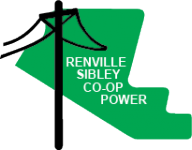What are "capital credits"? How do they benefit me? These are two questions you probably are wondering when learning about your cooperative. Capital credits are the maximum possible value for your rate dollar, and your share in the development of an expanding, progressive enterprise that is an active partner in the growth of the area you call home. Read on to find out how capital credits benefit you.
Equity is earned by the members each year from the profits of the business. These profits are termed margins and are allocated to the patrons buying power that year. In essence, these retained earnings displace the need for a portion of otherwise debt financing. In a cooperative, capital credits, like debt, need to be paid back to the lender. The lenders of debt are RUS and CFC. The lenders of equity are the customers who are paid back on a rotation basis with no interest. This is why the patrons are in essence equity owners of the cooperative.
The value of your equity is realized in the reduced cost of operation with this type of financing. It becomes a fine balance to maximize equity growth to obtain the lowest interest on loans, while attempting to return capital credits and maintain the lowest possible rates on the energy our members purchase. If Renville-Sibley could not use the members’ equity or “capital credits” to fund construction, we would have to borrow the funds. The additional interest expense on this debt would raise rates. Looked at that way, you do get a lot of value in exchange for allowing the cooperative to use your share of the margins.
